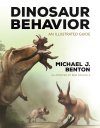By
Leon (NHBS Catalogue Editor)
26 May 2021
Written for Hardback

Fossils can tell us what animals living in the distant past looked like. Over the centuries, palaeontologists have made incredible strides in reconstructing extinct life forms, helped along by cumulative experience, technological advances, and a steadily increasing body of rare but truly exceptionally preserved fossils. But reconstructing their behaviour – surely that is all just speculative? In
Locked in Time, palaeontologist and science communicator Dean R. Lomax, with the able help of palaeoartist Bob Nicholls, presents fifty of the most exceptional fossils that preserve evidence of past behaviour: from pregnant plesiosaurs to a pterosaur pierced by a predatory fish. I was eagerly awaiting this book from the moment it was announced, but I was still caught off-guard by some of the astonishing fossil discoveries featured here.
Locked in Time effectively consists of fifty vignettes organised around five themes. Perhaps surprisingly, this is not the first popular science book on behaviour revealed by the fossil record. Anthony J. Martin wrote
Dinosaurs Without Bones in 2014, focusing on ichnology, the study of trace fossils such as fossil footprints, scratch marks, or nests. Lomax, however, casts his net far wider than just dinosaurs and has scoured the scientific literature for both trace and body fossils that reveal how these animals likely behaved in life. Some examples require careful inference, others, cases that the pioneer Arthur Boucot called "frozen behaviour", are blindingly obvious.
There are some truly astonishing fossils featured here. An ichthyosaur that died while giving birth proves beyond a doubt they were live bearing. A pair of turtles was unfortunate enough to end up caught in the act of mating for eternity. There are well-known fossils such as the pregnant mother fish
Materpiscis, the battle between a
Protoceratops and a
Velociraptor featured on the book's cover, or the tall spiral structures once nicknamed Devil's corkscrews by flummoxed fossil hunters that turned out to be burrows, some even containing fossilised beavers. There is violence: the skulls of two fighting male mammoths that died with tusks still interlocked; but also tranquillity: the fossil troodontid Mei long that was found in a posture reminiscent of modern-day birds resting or sleeping. There is the fossil that got Lomax started on this project: a metres-long trackway of a horseshoe crab scurrying over a lake bottom with the individual fossilised at the end of it! There is palaeopathology, parasites, and even fossil farts.
But make no mistake,
Locked in Time is much more than a book of trivia and factoids. Palaeoethology, the study of behaviour of organisms in the fossil record, is a proper subdiscipline of palaeontology and has bearings on the study of palaeoecology. And for all the spectacular fossils and occasional puns, Lomax also subtly educates his reader on more serious topics. Three things struck me in particular.
First, as Lomax acknowledges, not all interpretations of behaviour are uncontested. Are the fossils of the primitive bird
Confuciusornis sanctus that display exquisitely preserved ornamental feathers really males? Further research showed the fossils without these feathers to contain medullary bone, a temporary tissue associated exclusively with reproductively active females. The ornamented individuals showed no such evidence, strengthening the case for sexual dimorphism in this species. Or what of the 200-year-old claim that ichthyosaurs were cannibals? It took until the 1990s when further detailed studies of presumed stomach contents concluded that there were no signs of bite marks or etchings by stomach acids, strengthening the case that these were instead embryos. An important theme that Lomax highlights repeatedly is the utility of studying the behaviour of animals alive today. Although care is in order, comparisons with the behaviour of extant animals and the traces they leave can help demystify the behaviour of extinct animals.
Second, Lomax reveals the inner workings of palaeontology. It is not uncommon for fossils to linger for years or even decades after excavation pending the availability of funding and a skilled preparator. One specimen of the plesiosaur
Polycotylus latipinnus was dug up in 1987 but not prepared until 2011, finally revealing its pregnancy. Sometimes technological advances breathe new life into old fossils, such as the burrow containing the therapsid
Thrinaxodon liorhinus that was discovered in 1975. Not until 2013, when it was examined with powerful x-rays at a synchrotron facility, did the partially prepared fossil reveal a thus-far hidden injured amphibian that had crawled into the burrow and nestled itself against the likely dormant
Thrinaxodon. In other cases, palaeontologists have to beware frauds, as traders occasionally doctor fossils to make them fetch a higher price on the marketplace – some stories could just be too good to be true.
Third, Lomax proves himself to be a gentle educator. He will immediately explain jargon (e.g. Lagerstätten, ecdysis, or anamorphosis) and only introduce it where appropriate. And though this is popular science, Lomax is keen to bust myths. No, the large shark
Megalodon is no longer alive, and there is zero evidence for either
Dilophosaurus or other dinosaurs being capable of spitting acid, no matter what
Jurassic Park tried to tell you. He beautifully channels deep time when writing "Before dinosaurs even appeared, trilobites were already fossils under their feet" (p. 110), and explains why trace fossils are much more common than body fossils: "Over its lifetime, an animal might leave behind countless footprints [...] but only one skeleton" (p. 105).
Finally, seeing is believing, and
Locked in Time is richly illustrated. Most vignettes include photos and schematic drawings of the fossils, and my jaw dropped on numerous occasions. Given that disarticulated and fragmentary fossils are the norm, the selection that Lomax has curated here is truly breathtaking. Furthermore, all vignettes include a single or double-page spread with palaeoart from Bob Nicholls, tastefully reproduced in grayscale. He was featured in
Dinosaur Art and wrote the introduction to
Dinosaur Art 2 where he discussed his
Psitaccosaurus reconstruction mentioned here on p. 75. Nicholl's artwork is heavily informed by science and adds much flavour to this book.
Locked in Time is an outstanding and highly original piece of popular science that overflows with Lomax's enthusiasm and passion for his topic. Even if your shelves are already heaving with palaeontology books, make space for one more. Believe me, you have not seen a book like this before.



















































